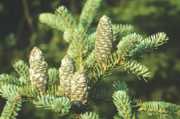

Common Name(s):
Eastern Fir, Canadian Balsam, Blister Fir
Genus: Abies
Species: balsamea

You can find the Balsam Fir in northeastern North America, from Virginia to Newfoundland and northwest towards Yukon and Labrador. The balsam Fir can be found in many biomes including the Taiga biome.
The Balsam Fir is a small to medium sized native evergreen tree. It can grow to be 40 to 80 feet tall. The Balsam fir has a wide base and a narrow top that ends in a slender, spirelike top. The brances grow from the trunk at right angles, with the lower brances spreading and drooping to the ground when the tree grows in the open. In a dense stands, many of the lower branches are dead. It can grow to be a maximum of 200 years old.
The Balsam Fir's needles are 1 1/2 inches long. They are flat, rounded at the tip, and normally have a strong curve. They are dark green above and whitened below. The balsam fir's bark is smooth thin and have a grayish color. Blisters of resin appear on the bark of old trees, from which it gets one of its common names. Balsam fir has a shallow root system that rarely grows deeper than 30 inches.
The cones stand upright on the 1st year growth of the upper branches. The tree produces its first seeds when it is 20 years old, or 15 feet tall. The seeds are winged and are mostly dispersed by the wind, traveling from 20 to 525 feet from the parent tree.
The Balsam fir is a late successional, or climax growth tree. This means that they grow in old, undisturbed forests. The Balsam fir is the least fire resistant of evergreen in North America, and its seeds are destroyed by fire. Balsam firs first appear 30 to 50 years after a fire.
Balsam fir is one of the major food supplies for moose in the winter. Caribou and white tailed deer leave it alone. Red squirrels will eat the male flower buds. Deer, caribou and moose use Balsam fir stands as cover in the winter because the snow is not as deep under them as in hardwood stands.
The wood of the Balsam Fir is sometimes used as lumber. It is lightweight, low in bending and low in resistance to shock as well. The tree is often used as a Christmas tree, pulpwood, or cabin logs.
Samantha S. 2000.
Bibliography:
"PLANTS-Topics", http://plants.usda.gov/, (June 2000)
"White Fir", http://mbgnet.mobot.org, (June 2000)
"Topics", http://www.fs.fed.us/database/feis/plants/tree/abibal/all.html